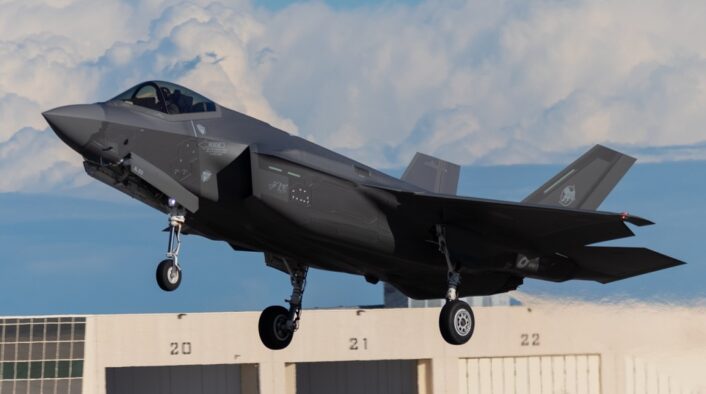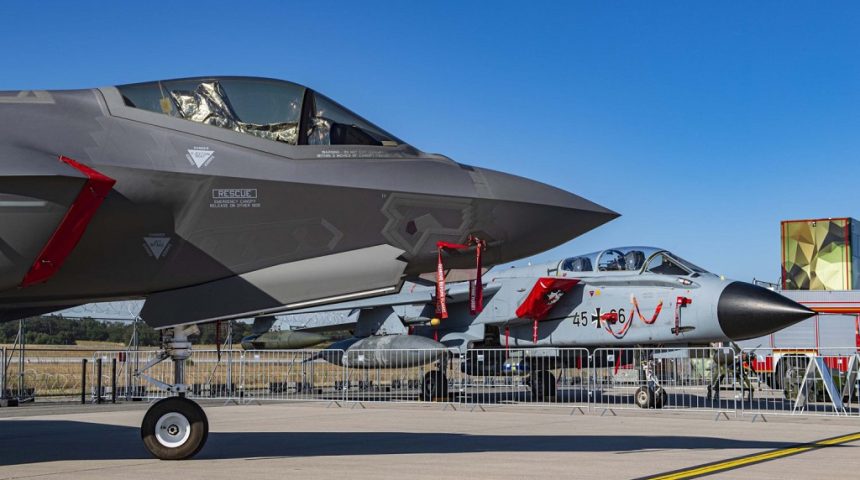The deliveries of the German 5th gen fighters will begin by 2026.
The German Ministry of Defense announced that a Letter of Acceptance (LoA) for the acquisition of 35 F-35 Lightning II fighter jets has been signed. The LoA finally puts an end to two years (at least) of continuous changes of mind by the German Air Force, as it moved from a first plan of a Eurofighter-only fleet to a mixed Eurofighter and Super Hornet/Growler fleet and, in the end, a mixed Eurofighter and F-35 fleet.
With the deal, which also includes weapons, equipment, training and support for an estimated total cost of USD 8.4 billion, Germany is now the ninth Foreign Military Sale country to acquire the 5th gen fighter jet. As mentioned in our previous articles here at The Aviationist, the F-35 was chosen because is considered the most suitable replacement for Germany’s retiring Tornado aircraft fleet in support of NATO’s nuclear sharing mission, while the F/A-18 Super Hornet and the Eurofighter 2000 would have required longer times because they need to be certified for the B61 nuclear bombs.
“Congratulations to Germany on procuring the F-35A. Germany is the ninth foreign military sales country to join the program,” said Lt. Gen. Michael Schmidt, F-35 Program Executive Officer. “We look forward to working with them to deliver the F-35 Air System to meet their national defense requirements.”
In addition to the 35 aircraft and their engines, the FMS includes two spare engines, 100x AIM-120C-8 AMRAAM air-to-air missiles; 75x AGM-158B/B2 JASSM-ER air-launched cruise missiles; 344x GBU-53 SDB II; kits for 162x GBU-31 JDAM bombs with BLU-109 2,000 lb warhead; kits for 246x GBU-54 Laser JDAM bombs with Mk-82 500 warhead; 75x AIM-9X Block II Sidewinder air-to-air missiles; inert weapons for training.
The presence of the AGM-158B/B2 Joint Air-to-Surface Standoff Missiles – Extended Range is interesting as it gives the German F-35s a low observable, long-range, all weather, precision standoff cruise missile. The weapon, however, can only be carried externally as, because of its size, it cannot fit inside the F-35’s weapon bays. Germany has also another cruise missile, the Taurus KEPD 350, which is employed by Tornado and Eurofighter, but with shorter range compared to the JASSM-ER.

The German parliamentary Budget Committee approved earlier this week the spending, which will use money from a 100 billion euro (USD 106 billion) special fund that Chancellor Olaf Scholz announced in days after Russia’s invasion of Ukraine in February to improve German military capabilities over the coming years and bring them back to acceptable standards. Defence Minister Christine Lambrecht however said: “This will probably not be enough to close the gaps that emerged over the past years because we neglected procurement.”
Training of German pilots on the F-35 is expected to begin in 2026 on the first German planes in the United States and then move to Büchel air base in Germany the following year. The Luftwaffe expects to declare an initial operational capability in 2028. Luftwaffe Chief of Staff Lt Gen. Ingo Gerhartz confirmed that the process to select a contractor to build the new facilities for the F-35 has already started and that officials will try to condense the permitting and construction process, which usually can take six or seven years, to meet the envisioned 2027 target.
As we already mentioned, the decision to base the F-35s there is not surprising: Büchel is the homebase of the Tornado IDS of the Taktisches Luftwaffengeschwader 33 (TLG33) and, above all, according to several reports (never been officially confirmed), it is also the base where the U.S. nukes required to fulfil NATO’s nuclear sharing agreement, are stored. By 2030, the nuclear strike mission will transition from the Tornado IDS to the F-35A, with the latter able to carry the B61-12 bomb in the internal weapons bay.
A portion of the German F-35s is expected to be built at the Final Assembly Check Out (FACO) facility in Cameri, Italy. “The most likely scenario would be that they receive some aircraft from Cameri and some aircraft from Fort Worth,” said J.R. McDonald, the vice president of F-35 business development at Lockheed Martin. “Building exclusively at Cameri may stretch out the delivery time.” The number of aircraft to be built in Italy, however, has not been disclosed.









